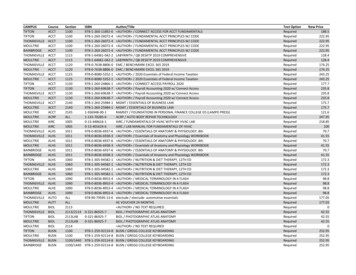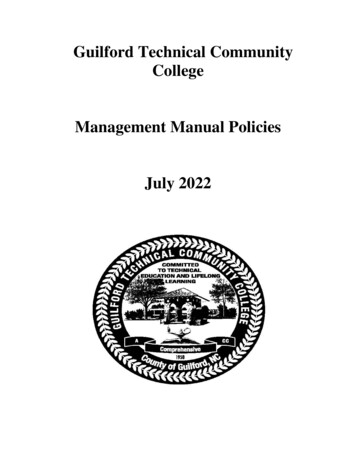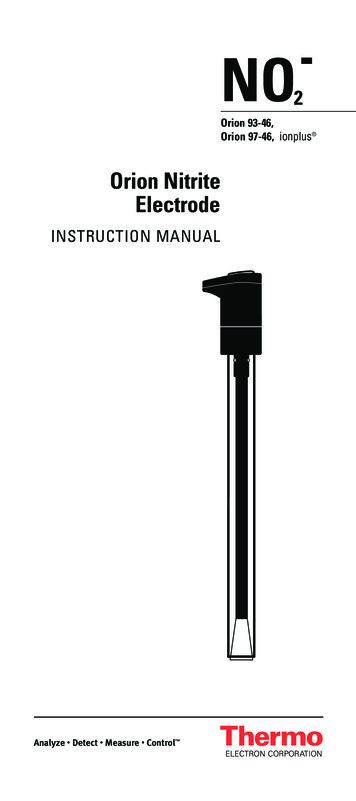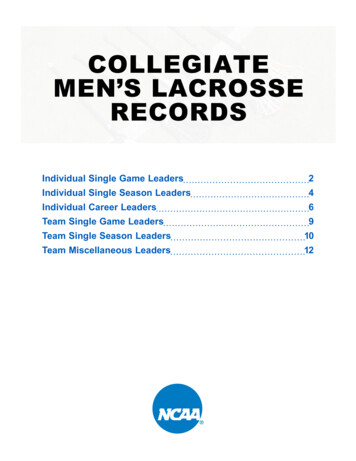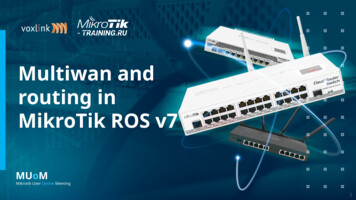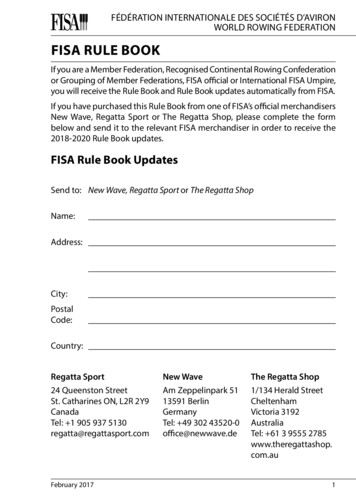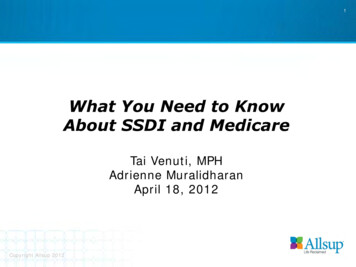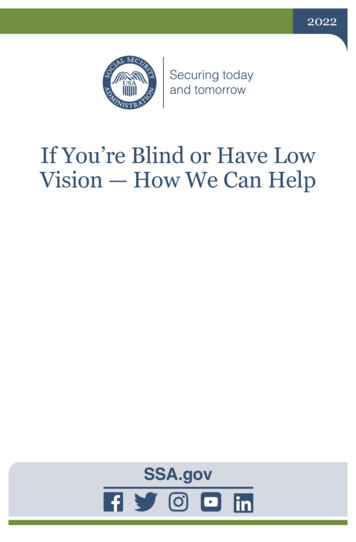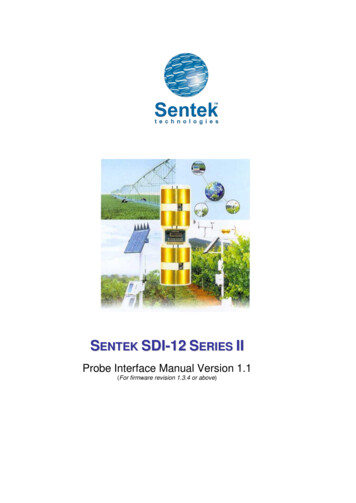
Transcription
SENTEK SDI-12 SERIES IIProbe Interface Manual Version 1.1(For firmware revision 1.3.4 or above)
Sentek SDI-12 Series II Probe ManualAll rights reserved. No part of this document may be reproduced, transcribed, translated into any language ortransmitted in any form electronic or mechanical for any purpose whatsoever without the prior writtenconsent of Sentek Pty Ltd. All intellectual and property rights remain with Sentek Pty Ltd.All information presented is subject to change without notice. 2001-2014 Sentek Pty LtdSentek , EnviroSCAN , EasyAG and TriSCAN are registered trademarks of Sentek Pty Ltd.Details of SDI-12 specifications can be obtained from the SDI-12 Support Group, Technical Committee, athttp://www.sdi-12.org/Sentek Pty LtdA.C.N. 007 916 67277 Magill RoadStepney, South Australia 5069Phone: 61 8 8366 1900Facsimile: 61 8 8362 8400Internet: http://www.sentek.com.auEmail: sentek@sentek.com.auSDI-12 Rev 1.1 (2014-01-10)Copyright 2001 – 2014 Sentek Pty Ltd All rights reservedPage i
Sentek SDI-12 Series II Probe ManualSentek - Statements of ComplianceFCC note of compliance and statement of liabilityElectro-Magnetic ComplianceThis equipment has been tested and found to comply with the limits for a Class B digital device,pursuant to part 15 of the FCC rules. These limits are designed to provide reasonable protection againstharmful interference in a residential installation. This equipment generates, uses and can radiate radiofrequency energy and, if not installed and used in accordance with the instructions, may cause harmfulinterference to radio communications. However, there is no guarantee that interference will not occurin a particular installation. If this equipment does cause harmful interference to radio or televisionreception, which can be determined by turning the equipment off and on, the user is encouraged to tryto correct the interference by one or more of the following measures: Reorientation or relocation of the receiving antenna.Connection of the equipment into an outlet on a circuit different from that to which the receiveris connected.Consultation with the dealer or an experienced radio/TV technician.EMC approvalsThe EnviroSCAN and EasyAG SDI-12 Series II probes comply with standard "EN61326:1997Amendment 1:1998, Amendment 2:2001, Amendment 3:2003 EMC standard for equipment formeasurement, control and laboratory use"The equipment complies with the following specifications: EN55011: 1998, Amendment 1: 1999 Radiated and conducted emissionsEN61000-4-2: 1995 Immunity to Electrostatic Discharge (ESD)EN61000-4-3: 2002 Immunity to Radiated Fields (RF)EN61000-4-4: 1995 Immunity to Electrical Fast Transients (EFT)/ BurstsEN61000-4-5:1995 Immunity to SurgesEN61000-4-6:1996 Immunity to Conducted RFFCC Part 15 Class BMarkingThe above EMC approvals allow the product to be marked CE, C-tick and FCC.ModificationsAny modifications to any part of the equipment or to any peripherals may void the EMC compliance ofthe equipment.Radio InterferenceThe probe is not to be operated in free air as it may cause interference to radio communication devicesCopyright 2001 – 2014 Sentek Pty Ltd All rights reservedPage ii
Sentek SDI-12 Series II Probe ManualTable of ContentsSentek - Statements of Compliance . iiFCC note of compliance and statement of liability.iiEMC approvals .iiMarking .iiModifications .iiRadio Interference .iiThe EnviroSCAN and EasyAG SDI-12 Probe Interface .1About the SDI-12 probe interface .1What is SDI-12? .1What are the EnviroSCAN and EasyAG SDI-12 probe interfaces? .1References .1What is the Intelligent Probe Configuration Utility? .1Setting the Probe Configuration .2SDI-12 Probe Interface. 4About setting up the EnviroSCAN and EasyAG SDI-12 probe interface .4Why do I need to configure the SDI-12 probe interface? .4SDI-12 Communication . 5About the SDI-12 Communication .5Power Sequence.5Timing .6Addresses.7Data Reading.7Data Reading using the Start Measurement Command (aM! or aMn!) .8Data Reading using the Start Concurrent Measurement Command (aC! or aCn!) 10Identification . 13Supported Commands . 14SDI-12 Commands Supported. 14Extended Commands Supported. 15EnviroSCAN Technical Specifications . 16EasyAG Technical Specifications . 18Circuit Information . 20Appendix A – Soil Moisture and Salinity Management . 21What soil volume does the SDI-12 probe interface measure at a single sensor? . 21What are the water units? . 21What part of the soil profile do multiple sensors on the probe measure?. 22Salinity Management . 22Appendix B - Sensor Specifications . 23EasyAG sensors . 23EnviroSCAN sensors . 23Appendix C- Troubleshooting . 24Copyright 2001 – 2014 Sentek Pty Ltd All rights reservedPage iii
Sentek SDI-12 Series II Probe ManualTable of FiguresFigure 1 Intelligent Probe Configuration Utility software .2Figure 2 Sentek SDI-12 probe interface communication power sequence .6Figure 3 Voltage levels on the SDI-12 line during an Acknowledge Active command (a!).6Figure 4: EnviroSCAN SDI-12 probe interface board layout. 16Figure 5 EasyAG SDI-12 probe interface board layout. 18Figure 6: SDI-12 interface circuit diagram . 20Figure 7 TTL interface circuit diagram . 20Figure 8: Measurements using metric units . 21Figure 9: Measurements using imperial units . 22Figure 10: Measurements of multiple sensors on the probe. 22Copyright 2001 – 2014 Sentek Pty Ltd All rights reservedPage iv
Sentek SDI-12 Series II Probe ManualThe EnviroSCAN and EasyAG SDI-12 Probe InterfaceAbout the SDI-12 probe interfaceThis section provides information about the EnviroSCAN and EasyAG SDI-12 probe interfaces.Note:Sentek Temperature and Humidity sensors require an EnviroSCAN probe interface with FirmwareSDI12 version 1.4.1 or later. Earlier versions will operate successfully but will not detect these sensors.What is SDI-12?SDI-12 (Serial Digital Interface at 1200 baud) is a standard communication protocol, allowingconnection of multiple sensors to an SDI-12 compatible data logger. SDI-12 communicates using acable containing three(3) conductors: a serial communication line a ground line a 12V lineThe EnviroSCAN and EasyAG SDI-12 probe interfaces support commands from version 1.2 of theSDI-12 communication protocol. For more information on SDI-12, visit www.sdi-12.org.What are the EnviroSCAN and EasyAG SDI-12 probe interfaces?The EnviroSCAN and EasyAG SDI-12 probe interfaces are used to allow an SDI-12 compatibledevice to communicate with and retrieve data from multiple Sentek sensors installed on a single probe.Both EnviroSCAN and EasyAG SDI-12 probe interfaces behave as a slave device, meaning they arenot capable of logging information or sampling data themselves. The interface must be attached to anSDI-12 compatible device acting as a master device, which will issue SDI-12 commands to instruct theprobe interface what to do. When instructed to sample data, the SDI-12 probe interface will retrievevalues from each sensor configured on the probe. These values are returned to the master device forstorage.The probe and its sensors are configured using the Intelligent Probe Configuration Utility (see sectionWhat is the intelligent Probe Configuration Utility?).References Sentek Probe Configuration UtilitySentek TriSCAN Agronomic User ManualSentek Calibration ManualWhat is the Intelligent Probe Configuration Utility?The Intelligent Probe Configuration Utility is provided to configure the EnviroSCAN and EasyAGSDI-12 probe interfaces with depth location, normalization values (air and water counts) andcalibration information for each sensor installed on the probe. This information is stored in nonvolatile memory, and is used to produce the calculated value (value that has been processed via theinterfaces calibration formula) from each sensor on the probe.Communication between the Intelligent Probe Configuration Utility and the EnviroSCAN andEasyAG SDI-12 probe interface is done using the Intelligent Probe Configuration Utility cable from acomputers communication port to the probe interfaces TTL port.Copyright 2001 – 2014 Sentek Pty Ltd All rights reservedPage 1
Sentek SDI-12 Series II Probe ManualNote: Temperature Sensors are currently not supported by the EnviroSCAN and EasyAG SDI-12probe interface.Note: Information stored in non-volatile memory will not be lost when power is removed from theSDI-12 probe interface.Figure 1 Intelligent Probe Configuration Utility softwareSetting the Probe ConfigurationThe Intelligent Probe Configuration Utility is provided to configure the EnviroSCAN and EasyAGSDI-12 probe interfaces with depth location, normalization values (air and water counts) andcalibration.Auto-detect SensorsAuto-detect Sensors will detect all sensors currently installed on the probe. After the sensors aredetected the configuration information (including type of sensor) will be displayed in the ProbeConfiguration list.All sensor information must be valid before the configuration can be written to the probe.Normalising SensorsNormalization is the setting of the range over which the sensor is effective. For example, soil moisturesensors have a range bounded by the 2 extremes, air and water. The normalization process is necessaryto adjust for any variances that may occur during the production of the sensor.Changing the Calibration InformationThe sensor coefficients cell is used to store A, B and C coefficients. The coefficients are entered in A, Bthen C order, separated by semicolons.It is possible to change the calibration coefficients through the Probe Configuration Utility: Moisture sensor A,B,C values should only be changed to reflect the characteristics of the soil inwhich the probe is installed. See the Sentek Calibration Manual for further information.Salinity sensor ABC values should not be changed.Temperature sensors ABC values are preset to supply values in degrees Celsius.Humidity sensors ABC values are preset to return humidity in the range 0% to 100%.Copyright 2001 – 2014 Sentek Pty Ltd All rights reservedPage 2
Sentek SDI-12 Series II Probe ManualSetting the SDI-12 AddressThe address of the probe should be in the range "0" to "9", "A" to "Z" and "a" to "z".Copyright 2001 – 2014 Sentek Pty Ltd All rights reservedPage 3
Sentek SDI-12 Series II Probe ManualSDI-12 Probe InterfaceAbout setting up the EnviroSCAN and EasyAG SDI-12 probe interfaceThis section provides information on setting up the EnviroSCAN and EasyAG SDI-12 probeinterfaces.Why do I need to configure the SDI-12 probe interface?The EnviroSCAN and EasyAG SDI-12 probe interface must be configured to ensure validinformation is reported to the data logger when data is requested. This information includes thenumber of sensors, normalization values (air and water counts) and calibration information.By default, each SDI-12 probe interface is supplied with an SDI-12 address of "0". If multiple probesare to be installed on an SDI-12 bus, each SDI-12 probe interface must be assigned a unique address(see section Addresses).Warning!Incorrect configuration information stored in the EnviroSCAN or EasyAG SDI-12 probe interface willresult in incorrect volumetric water content (mm/10cm) readings being reported to the controllingdevice.For more information on setting up the EnviroSCAN and EasyAG SDI-12 probe interface, refer tothe Intelligent Probe Configuration Utility online help.Copyright 2001 – 2014 Sentek Pty Ltd All rights reservedPage 4
Sentek SDI-12 Series II Probe ManualSDI-12 CommunicationAbout the SDI-12 CommunicationThis section provides information about the SDI-12 communication protocol used by theEnviroSCAN and EasyAG SDI-12 probe interfaces.Power SequenceFigure 2 shows the typical power consumption modes (at 12V) of the EnviroSCAN and EasyAGSDI-12 probe interface during communication with an SDI-12 compatible device.When power is applied, it takes about 750ms before the probe can process SDI-12 commands.The SDI-12 probe interface, at power up, will remain in idle mode for 150milliseconds. If a break is notreceived, the probe interface will be placed in sleep mode.An SDI-12 compatible device will send a break to wake all SDI-12 probe interfaces on the SDI-12 busbefore a command is sent. When this break is received, the SDI-12 probe interface will then be placedin idle mode, ready to communicate with the controlling device. The probe interface will remain in idlemode while the command is being processed. If a break (and valid communication) is not receivedwithin 150 milliseconds of the last command, the SDI-12 probe interface will be placed back into sleepmode.During a request to sample data, the SDI-12 probe interface will sample all sensors on the probe(sampling mode), then be placed into standby mode.See sections EnviroSCAN Technical Specifications and EasyAG Technical Specifications for current usagegraphs at different supply voltages.For more information on SDI-12 operation, visit www.sdi-12.org.Note: Valid communication must have an SDI-12 address included in the command that matches thatof the probe interface, and in the format of a valid SDI-12 command.Copyright 2001 – 2014 Sentek Pty Ltd All rights reservedPage 5
Sentek SDI-12 Series II Probe Manualsleep modeEnviroSCAN orEasyAG SDI-12 probeinterface in sleep mode0.5mAbreakidle modebreak150ms timeout20 mAValidcommunicationreceived?noyesidle modeProcess command(including response)20 mAsampling modesample sensors50-80mA(Moisture orSalinity orTemperature/humidityFigure 2 Sentek SDI-12 probe interface communication power sequenceTimingFigure 3 shows voltage levels on the SDI-12 line during transmission of an Acknowledge Activecommand (?!) using the "?" wildcard address.Figure 3 Voltage levels on the SDI-12 line during an Acknowledge Active command (a!)After the break condition has been sent to the EnviroSCAN or EasyAG SDI-12 probe interface byholding the line high (above 3.5V, spacing) for 12ms, the line is held low (below 1 V, marking) for aminimum of 8.3ms before the first character is transmitted.Each character transmitted consists of a Start Bit (spacing), followed by 7 data bits, followed by an evenparity bit, followed by a stop bit (marking). Characters are transmitted least significant bit (LSB) firstwith each bit in the character being 0.833ms wide.Copyright 2001 – 2014 Sentek Pty Ltd All rights reservedPage 6
Sentek SDI-12 Series II Probe ManualIn this example shown in Figure 3, there is no inter-character gap sent by the SDI-12 probe interface.The start bit for the second character follows immediately after the stop bit (marking) from the firstcharacter.Note: The EnviroSCAN and EasyAG SDI-12 probe interface will permit up to 4 bit-times betweencharacters before rejecting the command.Following the terminating character (!) of the command, the controlling device must release the linewithin 6.5ms. The EnviroSCAN and EasyAG SDI-12 probe interface will hold the line at the markinglevel for a minimum of 8.33ms before transmitting the first character of the response.AddressesThe EnviroSCAN and EasyAG SDI-12 probe interface accepts SDI-12 addresses in the range "0" to"9", "A" to "Z" and "a" to "z". Setting the probe interface address can be done using the ChangeAddress command (aAb!) (see SDI-12 Commands Supported) or using the Intelligent ProbeConfiguration Utility.Note: If the new address is invalid, the current address will be kept.Note: The probe interface will remain unresponsive for approximately 30 ms while the new address issaved in non-volatile memory.Note: The probe interface supports "?" (wildcard) as an address only for the Acknowledge Activecommand (a!).Data ReadingThe EnviroSCAN and EasyAG SDI-12 probe interfaces accept the Start Measurement command(aM! or aMn!) and Start Concurrent Measurement command (aC! or aCn!) for obtaining calibratedvalues from the probes sensors.Note: The EnviroSCAN and EasyAG SDI-12 probe interfaces do not support the ContinuousMeasurement command (aRn!). The probe will respond with a CR LF in response to thiscommand.The EnviroSCAN and EasyAG SDI-12 probe interface returns sensor values in sensor depth order,starting at the shallowest depth (i.e. 10 cm). A moisture or salinity sensor with a depth of zero (an unconfigured sensor) will not be reported by the SDI-12 probe interface.As the Start Measurement command (aM! or aMn!) reports how many sensor readings to expect, thecontrolling device should issue Send Data commands (aDn!) until it either receives a reply with no dataa CR LF , indicating that the probe abandoned sampling, or that all data has been received), oruntil it has received all of specified number of sensor values.For aMn! Commands, the probe will issue respond with a service request a CR LF when thesample data is available. The controlling device may request data (aDn!), either after the service requestor after the time specified in the response to the aMn! command.Note: The controlling device may choose not to issue all Send Data commands (aDn!) when retrievingthe data.Note: The EnviroSCAN and EasyAG SDI-12 probe interface currently uses a fixed format of "signfollowed by three digits, followed by the decimal point, followed by four decimal digits" ( nnn.nnnn)to return readings. This may change in future issues of the EnviroSCAN or EasyAG SDI-12 probeinterface firmware (software should not rely on this fixed format).Note 1: Valid soil moisture values will always be in the range 000.0000 to 101.0000. Soil moisturedata which would result in values in the range -0.1 to 0.0 will be returned as 000.0000. Any soilCopyright 2001 – 2014 Sentek Pty Ltd All rights reservedPage 7
Sentek SDI-12 Series II Probe Manualmoisture values outside of this range (caused by faulty sensors, incorrect probe installation orconfiguration) will be returned as -999.9999. A failed sensor will also return a value of -999.9999.Note 2: Some third party loggers cannot represent full 7-digit accuracy so convert -999.9999 to 1000.000.Note 3: The SDI-12 response time for Series II probes is less than the time in some examples.Data Reading using the Start Measurement Command (aM! or aMn!)The following table shows the allocation of the Start Measurement commands (aM! or aMn!):aM!Read Soil Moisture values 1 – 9aM1!Read Soil Moisture values 10 – 16aM2!Read Salinity values 1 – 9aM3!Read Salinity values 10 – 16aM4!Read Temperature values 1 – 9 (EnviroSCAN only)aM5!Read Temperature values 10 – 16 (EnviroSCAN only)aM6!Read Humidity values 1 – 9 (EnviroSCAN only)aM7!Read Humidity values 10 – 16 (EnviroSCAN only)Note: Start Measurement commands (aM! or aMn!) above "aM7!" will result in a response of"a0000 CR LF ".Soil Moisture Values (aM! and aM1!)The Start Measurement command (aM! or aM1!) allows up to nine (9) values to be returned. As it ispossible to have up to sixteen(16) soil moisture values from the SDI-12 probe interface, two(2) StartMeasurement commands (aM! or aM1!) are required. The Send Data command (aDn!) may return up tothree (3) values.CommandaM!Responsea0139 CR LF The response indicates that 9 soil moisture values will be available within a time of 13 seconds. Beforethe 13 seconds elapse the probe will issue a Service Request (a CR LF , where "a" is the probeaddress). The controlling device can then issue Send Data commands (aDn!) to read the values.CommandaD0!aD1!aD2!Responsea 001.0000 001.1234 000.0200 CR LF a 000.1234 000.0000 123.1234 CR LF a 010.1200 000.1243 044.8750 CR LF If there are more than 9 soil moisture values, a further Start Measurement command aM1! must beissued.CommandaM1!Responsea0117 CR LF The response indicates that another 7 soil moisture values will be available within a time of 11 seconds.Before the 11 seconds, the probe will issue a Service Request (a CR LF , where "a" is the probeaddress), and the controlling device will then issue Send Data commands (aDn!) to read the values.CommandaD0!aD1!aD2!Responsea 002.0010 003.1234 001.0200 CR LF a 011.1234 001.0100 011.3344 CR LF a 012.0230 CR LF Note: The Send Data commands (aDn!) must be issued in increasing order.Copyright 2001 – 2014 Sentek Pty Ltd All rights reservedPage 8
Sentek SDI-12 Series II Probe ManualSalinity Values (aM2! and aM3!)The Start Measurement command (aM2! or aM3!) allows up to nine (9) values to be returned. As it ispossible to have up to sixteen(16) salinity values from the SDI-12 probe interface, two(2) StartMeasurement commands (aM2! or a3M!) are required. The Send Data command (aDn!) may return upto three(3) values.CommandaM2!Responsea0239 CR LF The response indicates that 9 salinity values will be available within a time of 23 seconds. Before the 23seconds have elapsed the probe will issue a Service Request a CR LF , where "a" is the probeaddress. The controlling device can then issue Send Data commands (aDn!) to read the values.CommandaD0!aD1!aD2!Responsea 001.0000 001.1234 000.0200 CR LF a 000.1234 000.0000 123.1234 CR LF a 010.1200 000.1243 044.8750 CR LF If there are more than 9 salinity values, a further Start Measurement command (aM3!) must be issued.CommandaM3!Responsea0187 CR LF The response indicates that another 7 salinity values will be available within a time of 18 seconds.Before18 seconds elapse, the probe will issue a Service Request a CR LF , where "a" is the probeaddress, and the controlling device can then issue Send Data commands (aDn!) to read the values.CommandaD0!aD1!aD2!Responsea 002.0010 003.1234 001.0200 CR LF a 011.1234 001.0100 011.3344 CR LF a 012.0230 CR LF Note: The Send Data commands (aDn!) must be issued in increasing order.Temperature and Humidity (aM4! through aM7!)Temperature and humidity sensors are not available on EasyAG device. The (aM4! through aM7!)commands will get a reply of a0000!Each Start Measurement command (aMn!) allows up to nine values to be returned. As it is possible tohave up to sixteen(16) values from the EnviroSCAN SDI-12 probe interface, two Start Measurementcommands (aM4! and aM4! for temperature), or (aM6! And aM7! for humidity) are required. The SendData command (aD0! to aD2!) may return up to three values.CommandaM4!Responsea0039 CR LF The response indicates that 9 temperature values will be available within a time of 3 seconds. Beforeabout 3 seconds the probe will issue a Service Request a CR LF , where "a" is the probe address.The controlling device can then issue Send Data commands (aDn!) to read the values.If the data command aDn! requests data beyond the number of sensors reported by the aMn!Command, the response will be a!CommandaD0!aD1!aD2!aD3!Responsea 24.99402 24.52802 24.97996 CR LF a 24.52375 25.09555 24.48068 CR LF a 24.95815 24.38614 24.73441 CR LF a CR LF If there are more than 9 temperature values, a further Start Measurement command (aM5!) must beissued.CommandaM5!Responsea0027 CR LF Copyright 2001 – 2014 Sentek Pty Ltd All rights reservedPage 9
Sentek SDI-12 Series II Probe ManualData Reading using the Start Concurrent Measurement Command (aC! or aCn!)The following table shows the allocation of sensors for the Start Concurrent Measurement commands(aC! or aCn!):aC!Read Soil Moisture values 1 – 16aC1!Read Salinity values 1 – 16aC2!Read Temperature values 1 – 16 (EnviroSCAN only)aC3!Read Humidity values 1 – 16 (EnviroSCAN only)aC4!Read Soil Moisture Configuration values C constants 1 – 16aC5!Read Soil Moisture Configuration values B constants 1 – 16aC6!Read Soil Moisture Configuration values A constants 1 – 16aC7!ReservedaC8!Read Salinity Sensor Depth values 1 – 16aC9!Read Soil Moisture Sensor Depth values 1 – 16The EnviroSCAN and EasyAG SDI-12 probe interface will not issue a service request (a CR LF )for the aCn! Commands. So they can be issued to multiple probes (each with a different address)without waiting for the previous probe's data to be available. Data is not available for a probe until thetime specified in the response to the aCn! command.Note: Start Concurrent Measurement command "aC7!" will result in a response of"a0000 CR LF ".Soil Moisture Values (aC!)The Start Concurrent Measurement command aC! allows all soil moisture values to be sampled with asingle command. Values are gathered in the same way as for the Start Measurement command (aM! oraMn!), but the Send Data command (aDn!) may return up to eight (8) values.CommandaC!Responsea02116 CR LF The response indicates that 16 soil moisture values will be available after a time of 21 seconds. Thecontrolling device will then issue Send Data commands (aDn!) to read the values.CommandaD0!aD1!Responsea 001.0000 001.1234 000.0200 000.1234 000.0000 123.1234 010.1200 000.1243 CR LF a 044.8750 002.0010 003.1234 001.0200 011.1234 001.0100 001.0100 011.3344 CR LF Salinity Values (aC1!)The Start Concurrent Measurement command aC1! allows all salinity values to be sampled with a singlecommand. Values are gathered in the same way as for the Start Measurement command (aM! or aMn!),but the Send Data command (aDn!) may return up to eight(8) values.CommandaC1!ResponseA03616 CR LF The response indicates that 16 salinity values will be available after 36 seconds. The controlling devicewill then issue Send Data commands (aDn!) to read the values.CommandaD0!aD1!Responsea 001.0000 001.1234 000.0200 000.1234 000.0000 123.1234 010.1200 000.1243 CR LF a 044.8750 002.0010 003.1234 001.0200 011.1234Copyright 2001 – 2014 Sentek Pty Ltd All rights reservedPage 10
Sentek SDI-12 Series II Probe Manual 001.0100 001.0100 011.3344 CR LF Temperature and Humidity sensor values (aC2! and aC3!)Temperature and humidity sensors are not available on EasyAG devices. The (aC2! through aC3!)commands will get a reply of a0000!The Start Concurrent Measurement command aC2! and aC3! allow all temperature sensors or allhumidity sensor values to be sampled with a single command. Values are gathered in the same way asfor the Start
SDI-12 communicates using a cable containing three(3) conductors: a serial communication line a ground line a 12V line The EnviroSCAN and EasyAG SDI-12 probe interfaces support commands from version 1.2 of the SDI-12 communication protocol. For more information on SDI-12, visit www.sdi-12.org.



